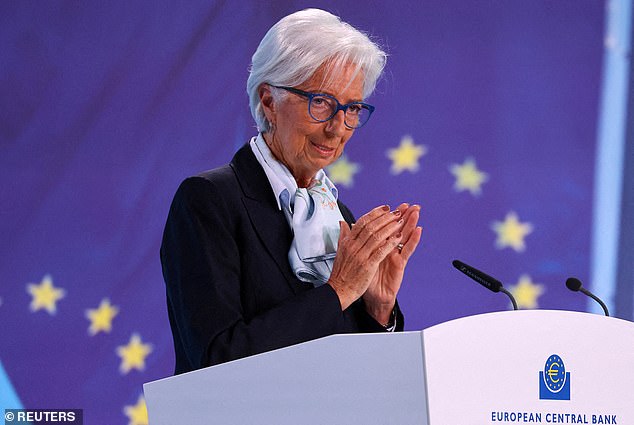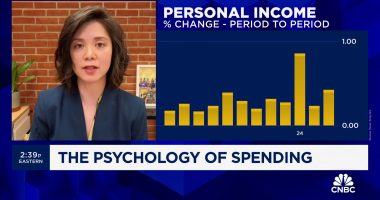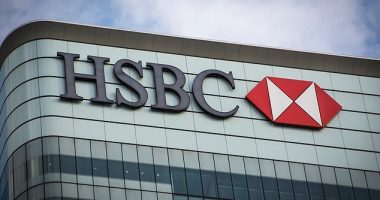The European Central Bank has cut interest rates for the first time in five years, with the eurozone’s key rate falling 25 basis points to 3.75 per cent.
However, the bank has also lifted its projections for eurozone inflation over the next 18 months and cautioned it will keep interest rates on a restrictive footing ‘for as long as necessary’.
The ECB marks the second G7 nation to push ahead with policy easing after the Royal Bank of Canada cut its key rate by 25 basis points (bps) to 4.75 per cent on Wednesday.
Economists and investors are now looking to the Bank of England to follow suit, with analysts divided over a summer base rate cut.


ECB president Christine Lagarde will be aware of the risks of straying too far from Fed policy
Markets had priced in the ECB’s first cut for some time, with the central bank having hinted at the direction of policy over the last few months as inflation eased and the bloc’s economy showed signs of stuttering.
The ECB said: ‘The dynamics of underlying inflation and the strength of monetary policy transmission, it is now appropriate to moderate the degree of monetary policy restriction after nine months of holding rates steady.’
But investors were looking to ECB commentary for guidance on the path ahead and were met with a conservative outlook.
Despite progress on inflation, the ECB conceded that ‘domestic price pressures remain strong as wage growth is elevated, and inflation is likely to stay above target well into next year’.
Its Eurosystem staff projections for both headline and core inflation have been revised up for 2024 and 2025 compared with forecasts in March.
The ECB now expects to see headline inflation averaging 2.5 per cent in 2024 and 2.2 per cent in 2025, before falling below its 2 per cent target at 1.9 per cent in 2026.
The bank said: ‘The governing gouncil is determined to ensure that inflation returns to its 2 per cent medium-term target in a timely manner.
‘It will keep policy rates sufficiently restrictive for as long as necessary to achieve this aim.
‘The Governing Council will continue to follow a data-dependent and meeting-by-meeting approach to determining the appropriate level and duration of restriction.
‘In particular, its interest rate decisions will be based on its assessment of the inflation outlook in light of the incoming economic and financial data, the dynamics of underlying inflation and the strength of monetary policy transmission.’
The ECB knows it must tread carefully after eurozone inflation rose from 2.4 to 2.6 per cent in May, while core inflation also ticked 20bps higher to 2.9 per cent.
The bank will also be keen to avoid decoupling monetary policy too far from that of the US Federal Reserve, whose first rate cut is now not expected until much later this year amid sticky inflation and surprisingly resilient economic performance in some areas, such as its labour market.
The fear is that by decoupling too far from US policy would lead to further pressure on the euro, which could both be reflationary and hurt growth. Similarly, the Bank of England will want to avoid similar issues for sterling in the months ahead.
Simon French, chief economist at Panmure Gordon said: ‘Central banks are mindful that with stubborn core inflation in the US, partly fuelled by firmer demand conditions than prevalent across the rest of the developed world, the exchange rate impact on imported inflation through a deterioration in US Dollar terms of trade is a material risk factor.
‘It is notable that the Swedish krona, Swiss franc, and Canadian dollar [where rate cuts have started] have weakened more materially than the UK pound and euro since the start of the year.
‘However, it should also be noted that both the krona and franc are now up on their USD value compared tothe day of the interest rate cut. This recovery will not go unnoticed in Frankfurt and London as they consider their own policy steps.’
Market pricing suggests the ECB will cut rates twice more before year-end, bringing the its key rate to 3.25 per cent.
When will the BoE cut?
Expectations for the timing of the first Bank of England interest rate cut have swung wildly this year, as fresh economic data has continued to upend market opinion.
Not long ago, market pricing suggested the BoE would join the ECB in a June rate cut, but it is now thought the UK’s central bank will cite still-high core inflation and the looming general election as reasons to hold off until August.
UK consumer prices index inflation rose by more than expected at 2.3 per cent in the 12 months to April, but down from 3.2 per cent the previous month, as core CPI proved to be frustratingly sticky at 3.9 per cent.
But construction industry data published on Thursday could offer some optimism to the Monetary Policy Committee when it meets on 20 June.
Thomas Pugh, economist at RSM UK, said: ‘The key news for the MPC was that the input prices index of the construction PMI dropped to 50.4, well below its five-year average of 66.2.
‘The takeaway from this is that April’s sticky inflation numbers were probably a direct response to the increase in the minimum wage, rather than a reflection of underlying price pressures. Price pressures are now easing across the economy.’
Market pricing suggests the BoE may only pull off two rate cuts at 25bps each this year, bringing base rate from its current level of 5.25 per cent to 4.75 per cent.
Analysts at UBS, however, are more optimistic and expect 75bps of BoE cuts this year – bringing base rate to 4.5 per cent by the end of 2024 – followed by 175bps in 2025.
UBS said: ‘However, in light of disappointing inflation data, we acknowledge the risk of a later cut, in August.
‘The markets currently price in 1bp of cuts by June, 9.5bps by August with the first rate priced in only by November.’
DIY INVESTING PLATFORMS
Affiliate links: If you take out a product This is Money may earn a commission. These deals are chosen by our editorial team, as we think they are worth highlighting. This does not affect our editorial independence.
Read More: World News | Entertainment News | Celeb News
Mail Online








